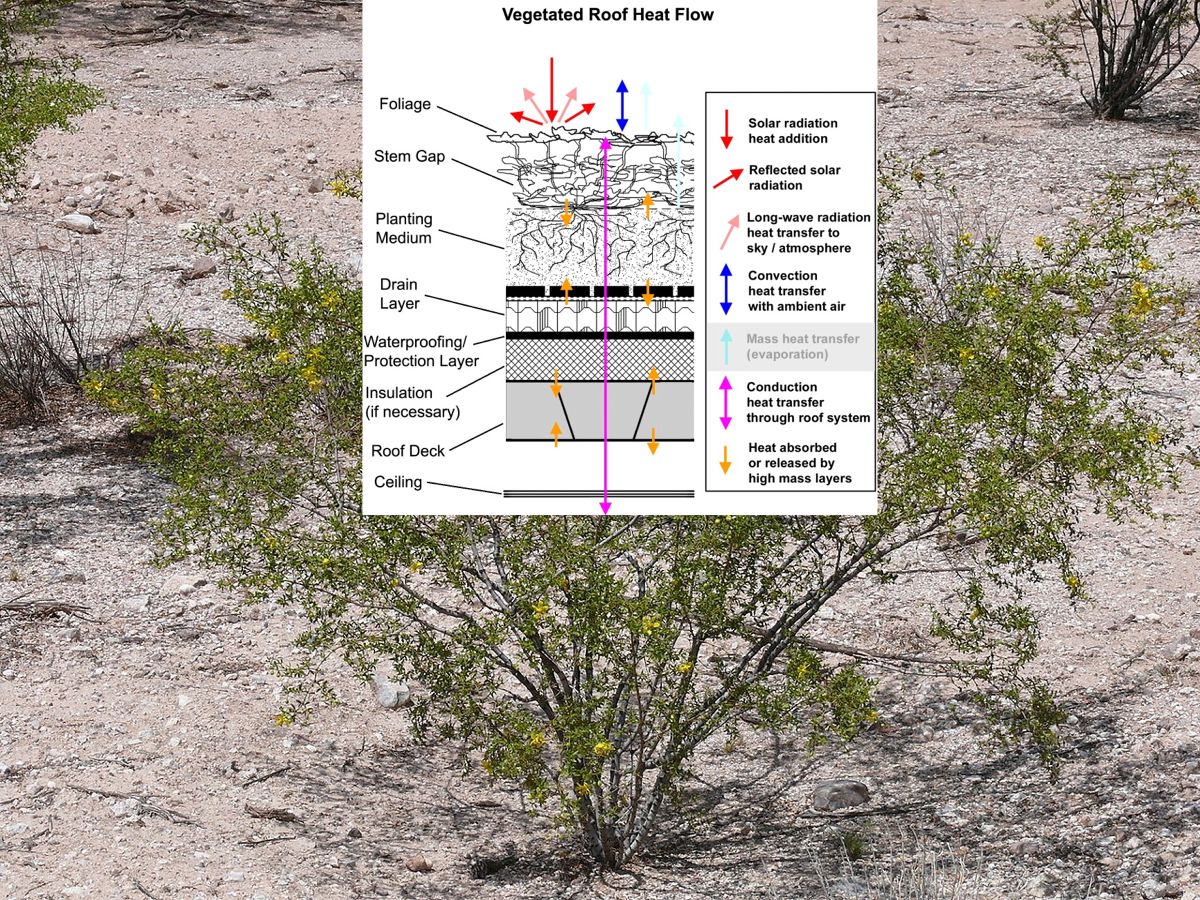“Cooler than Cool Roofs: How Heat Doesn’t Move Through a Green Roof”
“Cooler than Cool Roofs: How Heat Doesn’t Move Through a Green Roof” is the 7-part Green Roof Energy Series explaining the key aspects of green roof heat transfer issues and the best ways to take advantage of a green roof’s energy benefits by Greenroofs.com collaborator Chris Wark.
Green Roof Energy Series Part 3: Keeping Drought-Resistant Plants Cool
By Chris Wark, Energy Editor – Originally posted July 31, 2010
When I first started to research the thermal properties of plants, I was immediately drawn to the ones that thrive on extremely limited water availability – desert plants – particularly those in the southwestern U.S. states where daytime outdoor temperatures can be dangerously hot in the shade and stupid hot out in the sun. It is in the lower deserts of this region that we find plants that have been photosynthesizing quite happily in the driest, sunniest, 120 degree heat since before the advent of sprinkler systems. In the desert, nature simply doesn’t provide enough water year-round for plants to rely on evapotranspiration for cooling.
So, what kind of plants can thrive under these conditions and how do they cope with too much heat and not enough water?
The first plant most people would think of is a cactus with its pulpy stems, tough skin, and lots of big, sharp needles. But cacti, aloes, and other succulents fall into just one category of the following four different strategies used by desert plants:
1. Drought-escaping plants – Annual plants, such as wildflowers, that escape drought conditions altogether by going through their entire life cycle during a single rainy season (however short that may be). The rest of the time, when no water is available, only the seeds exist while waiting for the next rain.
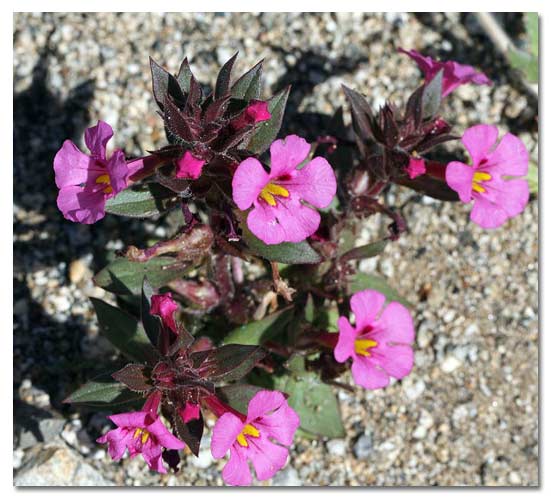
Bigelow’s Monkeyflower, Mimulus bigelovii. Image: DesertUSA
2. Drought-evading plants – non-succulent plants that ride out periods of drought. They simply stop growing, go dormant, or possibly die back when water is no longer available. Some species, like the desert lily, maintain a large pulpy root while the rest of the plant may go dormant.
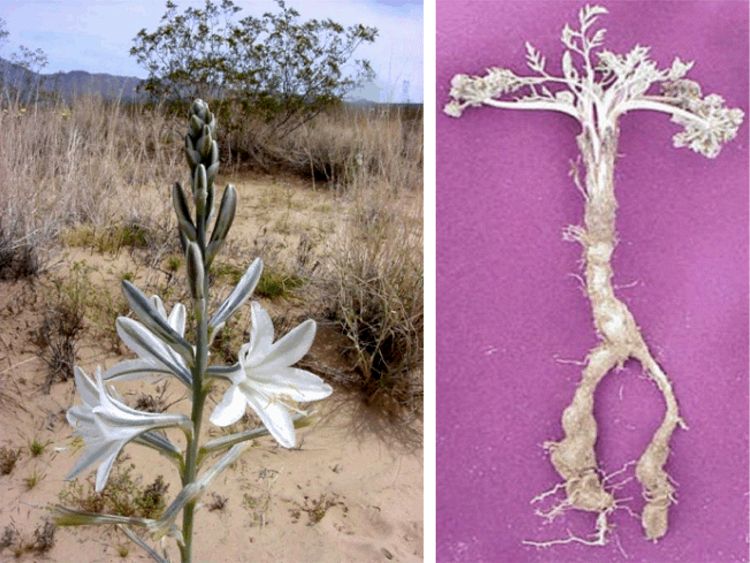
Left: Desert Lily, Hesperocallis undulata, in bloom. Image: calflora.net. Right: Desert Lily with roots, Image: CWNP
3. Drought-enduring plants – shrubs that keep growing even in times of extreme drought. They have extensive root systems that are usually shallow to capture occasional surface condensation and prohibit other plants from growing within several feet and competing for water. They stay cool by having small, pointy leaves. More on that later. The best, and possibly most widely studied example is the creosote bush.
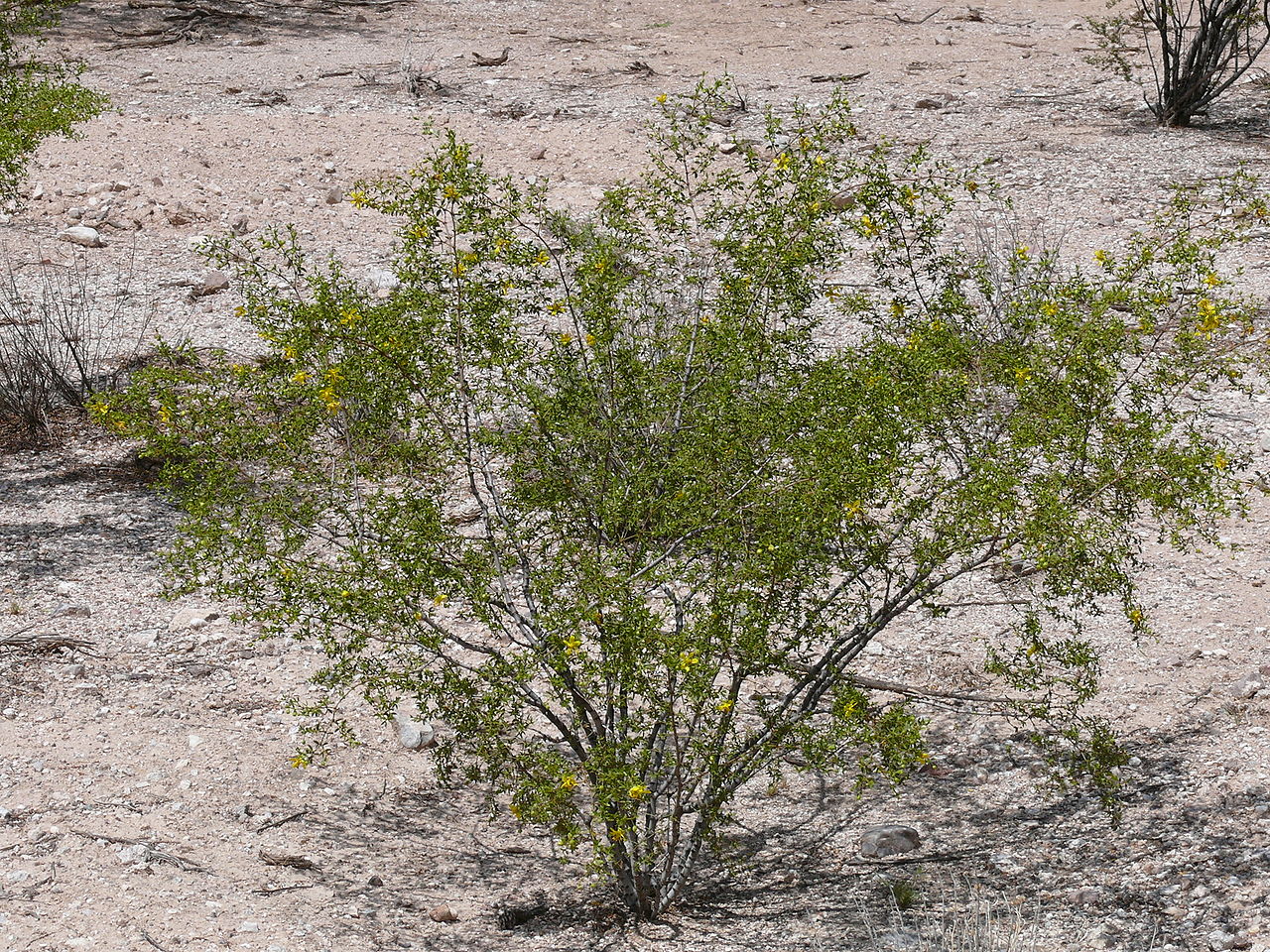
Young Creosote bush, Larrea tridentata Image: by Sue in az, Wikipedia, Public Domain
4. Drought-resisting plants – succulent perennials that store water in their stems, as in the case of cacti, or in their leaves, as in the case of aloe or, (Tada!), sedums.
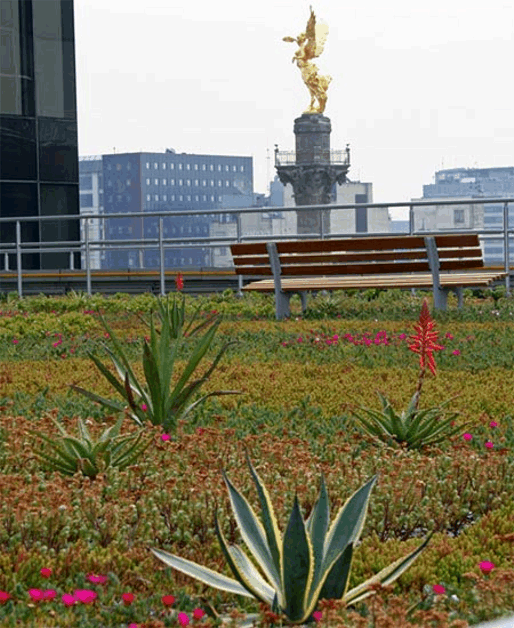
Succulents on the HSBC green roof in Mexico City. Image: AMENA
The first two groups are not great candidates for low-maintenance green roof designs since their thermal protection for the building is greatly diminished during the hottest months. Even worse, they may not adequately stabilize the planting media, keeping it from blowing or sliding away. Green roofs designed with these plants pretty much just look like a vacant lot for most of the summer until local weeds take over (not necessarily a bad thing), so let’s take a closer look at groups 3 and 4.
Even though Group 3, drought-enduring plants, tend not to work so well for green roofs since they typically inhibit the establishment and growth of other plants near them, their means of managing extreme heat is of great interest. Yes, they are able to collect and use water more efficiently than any other desert plants, but not enough to cool the plant, only enough to sustain photosynthesis. And yet, even with the sun beating down on them all day, the surface temperature of their leaves rarely rises more than a few degrees above the ambient air temperature.
This is where the small, pointy leaves come in. In some cases they are small compound leaves. The size and shape of these leaves are optimized for maximum convection between the leaves and surrounding air – any excess heat from the sun is quickly transferred to the air by even the slightest air movement across each leaf. They are also good at minimizing the overall intensity of the sun by partially shading each other during different parts of the day or by angling or curling away from the sun. On a roof, this means planting medium surface temperatures beneath these plants will not be higher than the ambient air temperature. Sure, it helps that these plants have adapted leaves that can live with 120 degree temperatures, but if they were large and horizontal, without access to copious amounts of water, their mid-day leaf temperatures would climb until the leaves were no longer large or horizontal.
Group 4, drought-resisting plants (succulents), use a completely different set of tactics. They are best known for swelling with water when it is available and saving it for a few hundred sunny days. Again, this water is usually not transpired during the day for cooling. In fact, transpiration typically only occurs at night when it is safer for the plant to open its stoma and breathe. It is the stored water that provides thermal mass which helps control the plants temperature – the water is able to absorb an impressive amount of heat during the day and release that heat at night. A large saguaro cactus may hold so much water that the temperature of its core can stay about half way between the average day and night temperatures through most of the dry season. The high water content also provides good heat conduction down to the ground.
But water storage isn’t the only way in which succulents manage excess heat in harsh desert climates. Most succulents also have a glossy or waxy leaf or stem surface that reflects sunlight. In many cases, the surface can get more reflective as the drought wears on.
And how about those needles? They do more than keep a cactus from being eaten. The needles can act as cooling fins, conducting heat out away from the body of a cactus to where the wind can remove the heat more efficiently through convection. Some smaller cacti, which do not have as much thermal mass, have adapted small, densely packed needles that help hold an insulating air layer at night and into the morning while partly shading the body during the day. The insulating needles also allow these cacti to endure freezing conditions much more effectively than cacti with sparse needles. The “fuzz” seen on the surface of many other succulents is simply an even smaller version of the compact needles.
Again, when these plants are used on a green roof, they guarantee that the planting medium beneath them will remain at or below the ambient air temperature since they are able to stay near the air temperature throughout the day.
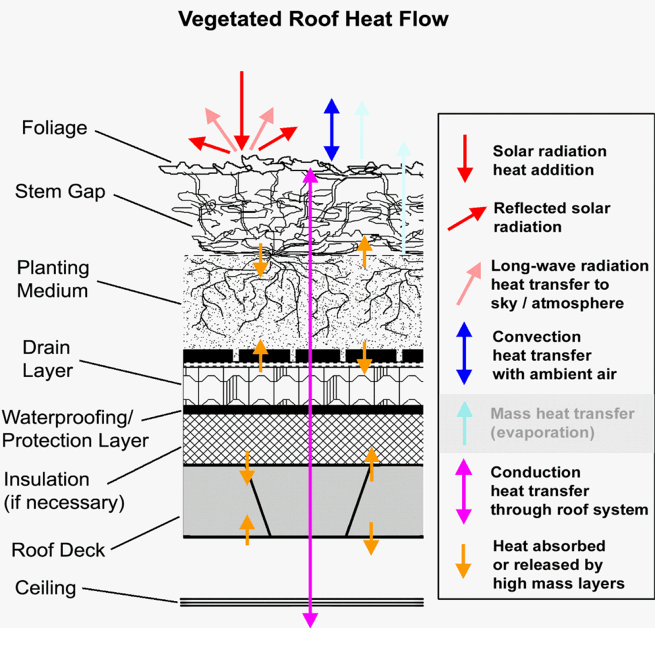
Copyright 2010 Christopher Wark
I have only pointed out a few of the wide variety and combinations of survival tools used by desert plants. The heat management examples used here included tactics for using convection (creosote bush leaves), conduction (cactus core), reflection (succulent skins), and thermal mass (water stored in succulents), all of which were discussed in Part 1: The Essentials – Heat Transfer by Layer of this series.
The upshot is that evapotranspiration is not necessary for a green roof to thrive or provide energy benefits for the building it covers. Even though nature provides 5 different ways to move heat, it turns out that 4 out of 5 ain’t bad.
Check in next month when the discussion gets “heavy.”
Copyright 2010 Christopher Wark
~ Chris Wark
References:
1. http://faculty.unlv.edu/landau/adaptations.htm Concise outline of desert plant adaptations.
2. www.eoearth.org/article/adaptations_of_desert_plants This section of the Encyclopedia of Earth has not been updated for some time but still gives some great descriptions of desert plant survival.
3. www.cwnp.org/adaptations.html Central Washington Native Plants website has some great images and provides a brief overview of plant survival methods in the arid region of central Washington state.
4. Lambers, Hans, et. al., Plant Physiological Ecology. Springer, 2008.
5. Mills, A.F. Basic Heat and Mass Transfer. Irwin, 1995.
Publisher’s Note:
See Chris Wark’s entire 7-part Green Roof Energy Series from 2010-2011 online and in PDF: “Cooler Than Cool Roofs: How Heat Doesn’t Move Through a Green Roof.“
Christopher G. Wark

Christopher Wark is Principal of Wark Energy Consulting and the founder of Ponix MicroAg LLC, a development-stage company that is creating a line of compact plant enclosures for the CEA market. Chris has over 30 years of multidisciplinary engineering experience providing mechanical, analytical, and electronics support and services to manufacturers, universities and national labs. He holds Bachelor and Master of Science degrees in Mechanical Engineering (with a minor in Materials Science) from Washington State University where his graduate work focused on thermodynamics, fluid dynamics, and combustion.
For the past 19 years, Chris has focused his efforts on the development and promotion of technical solutions in architecture and construction. He has provided energy and environmental quality analysis, CFD modeling, and LEED consulting services for several engineering and building consulting firms in New York and California. In 2002, Chris established SHADE Consulting/Green Roof Innovations (GRI) with his wife Wendy.
With GRI, Chris developed several innovative modular eco-roof systems and in 2010, Chris designed a modular planting system in partnership with Guiyang Chuangjia High-Tech Accelerator Co. LTD in Guiyang, China. In Guiyang, he saw how most of the apartment balconies and rooftops were filled with vegetable gardens. The idea of providing an improved environment for food production in built environments, along with key GRI design concepts, inspired the development of the patented pPod™ miniature greenhouse developed by Ponix MicroAg.
Contact Christopher Wark at: cwark@pponix.com, 917-565-6919.
 Greenroofs.comConnecting the Planet + Living Architecture
Greenroofs.comConnecting the Planet + Living Architecture
